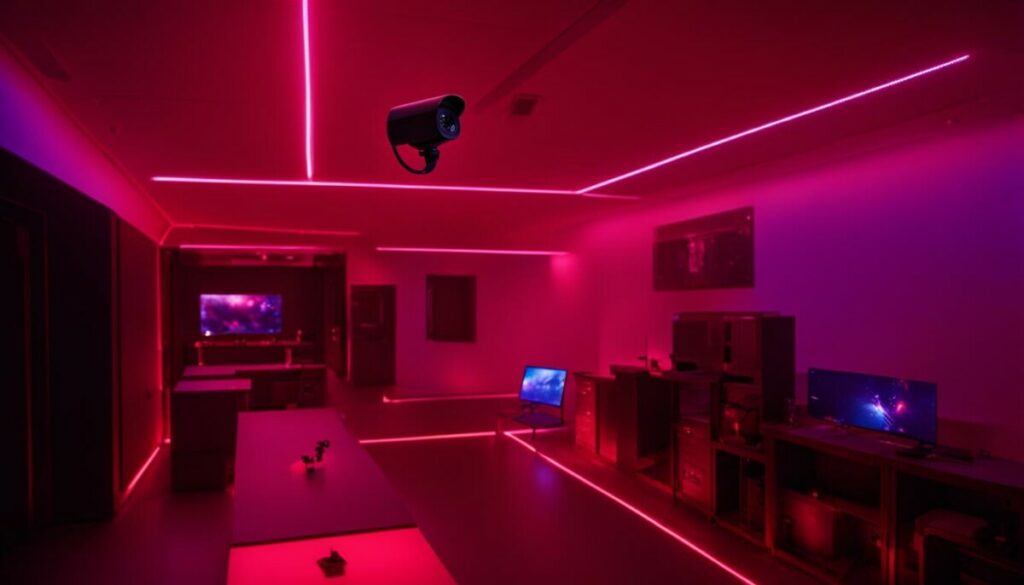Last Updated on 6 months by Francis
Infrared light is a type of electromagnetic radiation that is invisible to the naked eye. Infrared LED technology harnesses this invisible light to create a wide range of applications in various everyday devices. But how does this technology work? Let’s explore the fascinating world of infrared LED technology.
At its core, an infrared LED is a type of light-emitting diode that emits infrared radiation in the form of light. When electricity flows through the diode, it generates light at a specific wavelength that falls within the infrared spectrum. This process is known as electroluminescence.
Infrared LED technology has come a long way since its inception, and it continues to advance at a rapid pace. Today, infrared LED is used in a wide range of applications, including night vision technology, security systems, remote controls, and medical devices.
Contents
Key Takeaways:
- Infrared LED technology harnesses invisible light to create a wide range of applications in various everyday devices.
- An infrared LED is a type of light-emitting diode that emits infrared radiation in the form of light.
- Today, infrared LED is used in a wide range of applications, including night vision technology, security systems, remote controls, and medical devices.
The Working Principle of Infrared LED

If you ever wondered how infrared LED works, you’re not alone. These tiny yet powerful diodes are revolutionizing the way we interact with technology. Let’s take a closer look at the working principle of infrared LED.
Infrared LED works on a simple principle – when an electric current flows through a semiconductor material, it emits light. Infrared light is generated when the current flows through a specific type of semiconductor material, such as gallium arsenide or aluminum gallium arsenide. These materials are specially designed to emit light in the invisible infrared spectrum.
Unlike traditional LEDs that emit visible light, infrared LEDs emit invisible light that is beyond the range of human vision. This light falls between the wavelengths of 700 nanometers and 1 millimeter, making it invisible to the naked eye.
The Mechanism behind Infrared LED Operation
The operation of an infrared LED is based on the principle of electron-hole recombination.
When an electric current is passed through a semiconductor material, it causes electrons to move from the negative pole to the positive pole. As these electrons move through the material, they collide with atoms, releasing energy in the form of photons. This energy causes the electrons to jump to a higher energy level, leaving behind a positively charged hole.
When electrons recombine with holes, they release energy in the form of light. In the case of infrared LED, this light is in the form of infrared radiation.
Advantages of Infrared LED
Infrared LED has many advantages over traditional light sources. Firstly, it is incredibly efficient, with up to 80% of the energy consumed going towards emitting light. Secondly, it is long-lasting and can provide up to 50,000 hours of operation. Thirdly, it is small in size and can be easily integrated into a wide range of devices.
“Infrared LED is incredibly efficient, long-lasting, and small in size, making it an ideal choice for a wide range of applications.”
Infrared LED Applications in Night Vision Technology

One of the most fascinating applications of infrared LED is its use in night vision technology. IR LED illumination enables night vision devices to capture clear images in low-light or complete darkness. Instead of relying on visible light, which can be inadequate in low-light conditions, night vision devices use IR light to illuminate an area and capture the reflected light.
IR LED is particularly useful in military and law enforcement operations, where surveillance and reconnaissance activities often take place in the dark. The technology enables these professionals to see clearly in conditions where their enemies or suspects cannot, giving them a significant tactical advantage.
The Advantages of Infrared LED in Night Vision Technology
There are several advantages to using IR LED in night vision technology:
- IR LED illuminates a wider area than traditional flashlights or other visible light sources.
- It is less likely to be detected by the human eye, making it ideal for covert operations.
- IR light reflects off a wide range of surfaces, even those that are non-reflective, providing a clearer view of the environment.
- IR LED is energy-efficient and emits less heat than traditional light sources, reducing the risk of detection through thermal imaging.
The Different Types of Infrared LED Night Vision
There are two main types of night vision technology that utilize infrared LED:
- Active infrared night vision: In this type of technology, the device emits IR light and captures the reflected light to create an image. This is commonly used in military and law enforcement operations.
- Passive infrared night vision: This type of technology captures the natural IR radiation emitted by living organisms or objects and creates an image. This is commonly used in wildlife observation and surveillance.
The Future of Infrared LED Night Vision
As technology continues to advance, we can expect further developments in infrared LED night vision technology. Researchers are exploring ways to enhance image quality, increase the range of IR illumination, and make the technology more compact and affordable. These advancements could have far-reaching implications, from improving military operations to enhancing public safety and wildlife conservation efforts.
Infrared LED in Security Systems

Infrared LED technology has made significant contributions to the security industry. Its ability to provide clear visibility in low-light or dark environments makes it ideal for use in surveillance cameras and other security devices. Let’s explore some of the applications of infrared LED in security systems.
Infrared LED in Surveillance Cameras
One of the most common applications of infrared LED in security systems is in surveillance cameras. These cameras use infrared LED illumination to capture clear images in low-light or complete darkness. The infrared LED lights up the area being monitored, allowing the camera to capture images even when there is little to no visible light. This enables security personnel to monitor the area effectively, even at night.
Surveillance cameras with infrared LED also have the added benefit of being discreet. The infrared LEDs emit a faint red glow, but this is not visible to the human eye, allowing the cameras to remain hidden and inconspicuous.
Infrared LED in Motion Detectors
Infrared LED is also utilized in motion detectors, which are commonly used in security systems. These devices use infrared technology to detect movement in a particular area and alert security personnel. The motion detectors emit infrared light which is then reflected back to the device. If there is movement in the area being monitored, the reflected light pattern changes and the device is triggered, setting off an alarm to alert security personnel.
Infrared LED in Other Security Devices
In addition to surveillance cameras and motion detectors, infrared LED is also used in other security devices such as door and gate sensors. These sensors use infrared technology to detect movement near doors or gates and trigger an alarm if necessary. The use of infrared LED in security systems enhances visibility and detection capabilities, making them a crucial part of modern security systems.
The Role of Infrared LED in Remote Controls

Have you ever wondered how your remote control communicates with your TV, DVD player, or air conditioner? The answer lies in the magical world of infrared LED.
Infrared LED is widely used in remote controls as a way of transmitting data wirelessly. When you press a button on your remote, it sends a signal through infrared light to the device you want to control, telling it to perform a certain action.
The mechanism behind this is quite fascinating. Infrared light is a type of electromagnetic radiation that has a slightly longer wavelength than visible light. When you press a button on your remote, it activates a circuit that sends an electrical signal to the infrared LED. The LED then converts this electrical signal into infrared light and sends it out in a focused beam. This beam travels through the air to the device you want to control, where it is detected by an infrared receiver. The receiver then translates the signals back into electrical pulses, which are then decoded by the device and used to perform the desired action.
The use of infrared LED in remote controls has revolutionized the way we interact with our electronic devices. With just a press of a button, we can turn on/off a TV, adjust the volume, or switch to another channel. This convenience has made remote controls an essential part of our daily lives.
How Infrared LED Improves Remote Controls
Infrared LED has several advantages over other wireless communication methods in remote controls. One of the main benefits is that it is cheap and easy to manufacture, making it an affordable solution for mass production. Additionally, infrared light is directional, meaning it can be focused into a narrow beam that can be aimed precisely at the device you want to control. This makes it less susceptible to interference from other sources of light, such as sunlight or fluorescent bulbs.
Another advantage of infrared LED is that it is a point-to-point communication method, meaning that it only transmits signals between the remote control and the device it is controlling. This makes it a secure communication method, as it is less susceptible to interception or eavesdropping by other devices.
The Future of Infrared LED in Remote Controls
The use of infrared LED in remote controls is likely to continue for the foreseeable future. However, there are some limitations to its use, such as the need for a direct line of sight between the remote and the device being controlled. This has led to the development of new wireless communication methods, such as Bluetooth and Wi-Fi, which do not require line-of-sight and can work over longer distances.
Despite these limitations, infrared LED remains an important technology in remote controls and is likely to continue to be used in the future. As technology continues to advance, we can expect to see improvements in the efficiency and range of infrared LED, making it an even more powerful tool for wireless communication.
Infrared LED in Medical Devices
Medical devices have always relied on cutting-edge technology to provide accurate and efficient diagnostics to patients. Infrared LED has become an integral part of this technology, finding applications in various medical devices. These devices use infrared light to measure various bodily functions and provide non-invasive treatments for conditions such as pain and inflammation.
Blood Oxygen Monitors
One of the most widespread applications of infrared LED in medical devices is in blood oxygen monitors. Blood oxygen monitors use infrared light to measure the oxygen saturation level in the blood. This vital sign is crucial for detecting hypoxia, which is when the body doesn’t receive enough oxygen. Hypoxia can lead to severe respiratory distress and organ failure, making early detection critical. Infrared LED technology enables these monitors to detect small changes in oxygen saturation level accurately. It is a non-invasive method that makes it easier to measure oxygen saturation in patients.
Thermometers
Infrared LED technology is also used in thermometers. These devices use infrared light to measure body temperature without physical contact. The thermometer measures the thermal radiation emitted by the eardrum or the forehead and converts it into a temperature reading. It is a more hygienic and accurate method as it eliminates the need for direct skin contact.
Light Therapy Devices
Infrared LED technology has also found application in light therapy devices. These devices use infrared light to penetrate the skin and provide healing benefits. The infrared light stimulates the production of collagen and increases blood circulation, which promotes healing. These devices are used to treat conditions such as pain, inflammation, and skin problems. They are non-invasive and a safer alternative to medication-based treatments.
| Medical Device | Infrared LED Application |
|---|---|
| Blood Oxygen Monitors | Measuring oxygen saturation levels |
| Thermometers | Measuring body temperature without physical contact |
| Light Therapy Devices | Stimulating collagen production and increasing blood circulation |
As technology continues to advance, we can expect to see even more innovative uses for infrared LED in medical devices. With its non-invasive and accurate nature, it has the potential to revolutionize healthcare diagnostics and treatments.
Infrared LED Applications in American Homes

Aside from its use in specialized devices, infrared LED has made its way into American homes as well.
Smart Home Devices
Many of the devices that make our homes “smart” utilize infrared LED technology. Smart bulbs, for example, allow for customizable lighting and can be controlled with a mobile app or voice commands through a virtual assistant.
Infrared LED technology is also used in home security systems, such as motion detectors and intrusion sensors. By using infrared LED, these devices can detect movement and send alerts to homeowners or security professionals.
Remote Controls
Another everyday use of infrared LED technology is in remote controls for electronic devices such as televisions, sound systems, and air conditioning units. Through infrared signals, the remote control sends commands to the device, allowing users to control it from a distance.
Other Applications
Infrared LED technology is also present in other common household devices such as thermometers and baby monitors. They use infrared sensors to detect temperature and motion, respectively.
Overall, infrared LED technology has become an essential part of our daily lives and has improved everyday convenience in American homes.
The Advancements in Infrared LED Technology

Over the years, there have been significant advancements in infrared LED technology, making it more efficient and versatile in various applications. These advancements are what have made infrared LED technology more accessible and easy to integrate into everyday devices.
Improved Efficiency
One of the significant advancements in infrared LED technology is the improvement in their efficiency. Manufacturers have been able to design infrared LED lights that consume less energy and deliver more output.
The efficiency of infrared LED lights is measured by the amount of power consumed concerning the amount of light produced. The measure of efficiency is measured in Lumens per watt (LPW). For the early infrared LED technology, the LPW was about five, meaning that it consumed five watts to produce a lumen. However, with the advancements, the LPW has increased to up to 100, making the infrared LED lights more efficient and cost-effective.
Increased Power Output
The early infrared LED technology had a low power output, making it impossible to use in some applications. However, with the advancements in technology, the power output of infrared LED has increased significantly.
The power output of infrared LED is measured in milliwatts (mW). Early infrared LED technology had a power output of around 10mW, making it limited to specific applications. However, with the advancements in technology, power outputs of up to 500mW have been achieved, making it possible to use in various applications such as security systems, medical devices, and even in automotive lighting.
Miniaturization
The advancements in infrared LED technology have also led to miniaturization, making it possible to incorporate infrared LED into smaller devices. Manufacturers can now produce smaller infrared LED lights that can be integrated into smart home devices, remote controls, and even wearable medical devices.
The miniaturization of infrared LED technology has also led to the production of smaller and more efficient night vision devices. Military equipment has benefited greatly from this development, with soldiers being able to use smaller and more efficient night vision devices that allow them to scout the battlefield without being detected.
| Advancements in Infrared LED Technology | LPW | Power Output (mW) |
|---|---|---|
| Early Infrared LED Technology | 5 | 10 |
| Current Infrared LED Technology | Up to 100 | Up to 500 |
“The advancements in infrared LED technology have made it possible to use it in various applications, making it more accessible and easy to integrate into everyday devices.”
In conclusion, the advancements in infrared LED technology have led to increased efficiency, power output, and miniaturization, making it more accessible and versatile in various applications. With the continued advancements, we can expect to see even more innovative uses of infrared LED technology in the future.
Future Possibilities with Infrared LED

As discussed earlier, infrared LED technology has evolved significantly over the years, and we can expect even more exciting and innovative possibilities in the future. The advancements in infrared LED technology are opening new doors for applications in various industries, including healthcare, security, and consumer electronics.
One potential application is the development of infrared-based communication technology. Infrared LEDs could be used to create secure communication channels that cannot be intercepted by radio frequency (RF) or other wireless signals. This technology can be utilized in industries such as finance and defense, where secure communication is critical.
Infrared LED technology is also being explored for medical applications. Researchers are investigating the potential of infrared LED therapy to treat various health conditions, including wound healing, pain relief, and skin rejuvenation. Infrared LED therapy has already been FDA-approved for the treatment of chronic joint pain and arthritis.
Another exciting possibility is the use of infrared LED in 3D printing. Researchers have developed a method that uses infrared LED to cure a printed object much faster than traditional UV-light-based curing methods. This advancement could significantly improve the efficiency of 3D printing and open up new applications in industries such as aerospace and automobile manufacturing.
Advancements in Infrared LED Technology
The future of infrared LED technology looks promising, with continuous advancements in efficiency, power output, and miniaturization. Infrared LEDs have become an integral part of many electronic devices, from TV remotes to surveillance cameras to medical equipment.
As technology continues to evolve, we can expect even more innovative applications of infrared LED, improving our lives and enhancing the capabilities of various industries. The possibilities are endless, and the future of infrared LED is indeed exciting.
Exploring the Invisible: Infrared LED Technology Unveiled
https://www.youtube.com/watch?v=ribnTbFtfUE
Have you ever wondered how your TV remote works? Or how security cameras capture clear images in the dark? The answer lies in infrared LED technology. Infrared light emitting diodes (LEDs) are at the heart of many everyday devices, enabling them to perform essential functions that make our lives easier and safer.
So, what exactly is an infrared LED? These devices are similar to regular LEDs, with one key difference – they emit light in the infrared part of the electromagnetic spectrum, which is invisible to the human eye. Infrared light has longer wavelengths than visible light, allowing it to penetrate materials like fog, smoke, and even human skin.
Infra-red light is a type of electromagnetic radiation and is one of our universe’s most common forms of energy. It is used for remote controls, night vision, and thermal imaging. However, the light we see with our eyes doesn’t include infrared radiation, which is why it is “invisible.” Infrared rays have wavelengths that are longer than those of red light, which is why they are called “infra” (below)
The technology behind infrared LEDs is fascinating. Infrared LEDs are made up of materials such as gallium arsenide or aluminum gallium arsenide that have been doped, or treated with impurities. These impurities create a depletion region, which has a lower concentration of electrons than the surrounding regions. When a voltage is applied to the diode, electrons flow from the n-type side to the p-type side, where they recombine with holes in the semiconductor material. This recombination process emits light in the form of photons, which are then emitted as infrared radiation.
Infrared LEDs have come a long way since they were first invented in the 1960s. Today’s infrared LEDs are smaller, more efficient, and more powerful than their predecessors. These improvements have allowed for their integration into a wide range of devices, from smartphones to medical equipment.
The Future of Infrared LED Technology
The possibilities with infrared LED technology are endless. As advancements continue, we can expect even greater uses for this invisible light. For example, scientists are studying the use of infrared LED in cancer treatments to destroy cancerous cells while leaving healthy cells unaffected. Infrared LED could also be used to create more efficient solar panels, as well as in the development of augmented reality devices.
As we continue to unravel the mysteries of infrared LED technology, we gain a deeper appreciation for the hidden world of electromagnetic radiation that surrounds us. From everyday conveniences to life-saving medical applications, infrared LED has become an essential part of our modern lives.
Conclusion
In conclusion, infrared LED technology is a fascinating topic that warrants further exploration. We have learned about the working principles of infrared LED, its applications in various fields, and the advancements in its technology.
The Future of Infrared LED
As technology continues to evolve, the potential for infrared LED is limitless. The development of new materials and manufacturing techniques is driving down costs while increasing performance and efficiency.
The Invisibility Advantage
The fact that infrared light is invisible to the naked eye gives it a unique advantage in many applications. For example, it is ideal for use in night vision technology, as it allows us to see without being seen.
Integration with Other Technologies
Another exciting aspect of infrared LED technology is its integration with other technologies, such as artificial intelligence and the internet of things. This integration is opening up new possibilities for smart homes, medical devices, and security systems.
In summary, the potential for infrared LED technology is vast, and its applications are only limited by our imagination. As we continue to push the boundaries of what is possible, we can expect to see even more exciting applications of this remarkable technology in the years to come.
FAQ
How does infrared LED work?
Infrared LED works by emitting infrared light, which is invisible to the human eye. It generates light through the process of electroluminescence, where electric current passes through a semiconductor material, causing it to emit photons in the infrared spectrum.
What is the working principle of infrared LED?
The working principle of infrared LED involves the conversion of electrical energy into light energy. When a voltage is applied to the LED, it allows electrons to move across the semiconductor junction, releasing energy in the form of photons, which are emitted as infrared light.
What are the applications of infrared LED in night vision technology?
In night vision technology, infrared LED is used to provide illumination in low-light or complete darkness. It enables night vision devices, such as cameras and goggles, to capture clear images by emitting infrared light that is then detected and converted into visible images.
How is infrared LED used in security systems?
Infrared LED plays a crucial role in security systems by enhancing visibility and enabling effective monitoring. It is used in surveillance cameras, motion detectors, and other security devices to provide infrared illumination, allowing for clear image capture even in low-light conditions.
How does infrared LED work in remote controls?
Infrared LED is integrated into remote control devices to transmit signals to various electronic devices. When a button is pressed on the remote control, the infrared LED emits a series of infrared light pulses that carry encoded commands. These pulses are then detected by the electronic device, triggering the corresponding action.
What are the applications of infrared LED in medical devices?
Infrared LED finds applications in medical devices such as blood oxygen monitors, thermometers, and light therapy devices. It helps in non-invasive diagnostics, temperature measurement, and therapeutic treatments by emitting infrared light that interacts with biological tissues and molecules.
How is infrared LED used in everyday household devices?
In American homes, infrared LED is utilized in smart home devices like smart bulbs, home security systems, and voice assistants. It enables remote control, automation, and hands-free operation of these devices, providing enhanced convenience and connectivity.
What are the advancements in infrared LED technology?
Advancements in infrared LED technology include improvements in efficiency, power output, and miniaturization. These advancements have led to the integration of infrared LED into a wider array of devices and applications, providing better performance and energy efficiency.
What are the future possibilities with infrared LED technology?
The future possibilities with infrared LED technology are vast and exciting. There could be advancements in imaging capabilities, enabling higher resolution and more accurate imaging. It could also lead to enhanced security systems and innovative medical applications, pushing the boundaries of what is currently possible.
How does infrared LED technology work?
Infrared LED technology works by utilizing light-emitting diodes that emit infrared light when electric current passes through them. These diodes are composed of semiconductor materials, such as gallium arsenide or indium gallium arsenide, which emit light in the infrared spectrum when electrons recombine with electron holes.









